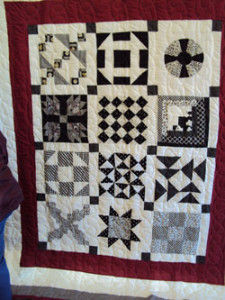
A quilt made by the Pleasant Hill Quilting Group of Linden, Texas, showing the different quilt patterns used in guiding runaway slaves to safety.
The last Saturday in February, the Pleasant Hill Quilting Group of Linden in Cass County presented an outstanding program for the public in Emory. Over 100 persons were in attendance to see the quilts those talented ladies made and learn a very interesting bit of history.
Using Hidden in Plain View: A Secret Story of Quilts and the Underground Railroad by Jacqueline L. Tobin and Raymond G. Dobard, the Pleasant Hill ladies recreated quilt patterns that led members of Ozella Williams’ family to freedom before the Civil War. With ten quilt patterns and songs known as spirituals, the Pleasant Hill ladies took the audience along the dangerous route of the Underground Railroad to freedom in the north, and in Canada after the Fugitive Slave Act passed in 1850.
Most of the quilters belonged to the Prairie Grove Missionary Baptist Church in Linden. All but two were retired schoolteachers; each of whom taught between thirty and forty-three years. The other two retired after thirty plus years in Civil Service. Dressed in period costumes, the ladies sang songs and explained how visual clues in quilts aided the escaping slaves, giving them inspiration and providing communication. The quilt patterns pointed the way, a virtual map of cloth.
Free Blacks and abolitionists risked their lives to provide food, clothing, and shelter to runaway slaves. They would hang a quilt in the window or place it in on a bush outside to signal a safe house. The first pattern was known as the Monkey Wrench, directing the runaway to the next quilt with a Wagon Wheel pattern. Many of the refugees actually rode in wagons once they were north of the Mason-Dixon lines. Straw and sunbonnets hid the passengers until the next safe house.
The Bear Paw pattern pointed the escapee further north. The fourth pattern, Crossroad, was a high point in the escape process. That meant that journey was half way over, it was a time to receive food, clothing, and help. Cleveland, Ohio, was closely identified with the Crossroad pattern.
Any house, church, or barn with a quilt featuring the Log Cabin pattern was considered a safe house. The next step to freedom occurred when the Shoofly pattern appeared on quilts. The escapees knew to scatter and meet again in a nearby cemetery.
A relatively simple pattern, the Bow Tie, signified it was time to shed old clothes and change into clean ones provided by abolitionists and Free Blacks. The Flying Geese pattern and the Drunkard’s Path pattern continued to signify hope and inspiration for the runaways. Finally, the North Star or the Star of Bethlehem was seen as the slave neared true freedom.
After 1850 it became imperative that slaves be transported into Canada. Here they usually traveled by water; hence the Sail Boat pattern became a secondary symbol of the Underground Railroad. Many Free Blacks either owned the boats or worked in a prominent position allowing safe passage for escapees.
Most slaves who successfully fled used the Underground Railroad system of aid and assistance. Generally, they were men who traveled alone from the Border States of Maryland, Delaware, and Kentucky. Harvard Press has recently published a new book To Free a Family by Sydney Nathans. Reviews indicate that Mr. Nathans did an excellent job reconstructing the true story with letters, family papers of the slave owner, and the archives of Boston abolitionists. It sounds like fascinating reading.

Thank you Carol! They will be back here on Feb.25th 2017 ! Dcottye and I are going !!
I would love to buy the quilt or learn to make. My family is from Ky and came to Ohio. I was one of the first generations born in Ohio.